For now, love yourself and enjoy this one ...
Now love yourself and enjoy this one ...
Make your rice the star of the meal with this recipe for Coconut Cilantro Lime Rice—a fluffy bed of jasmine cooked in coconut milk and served with a hint of lime and fresh cilantro.
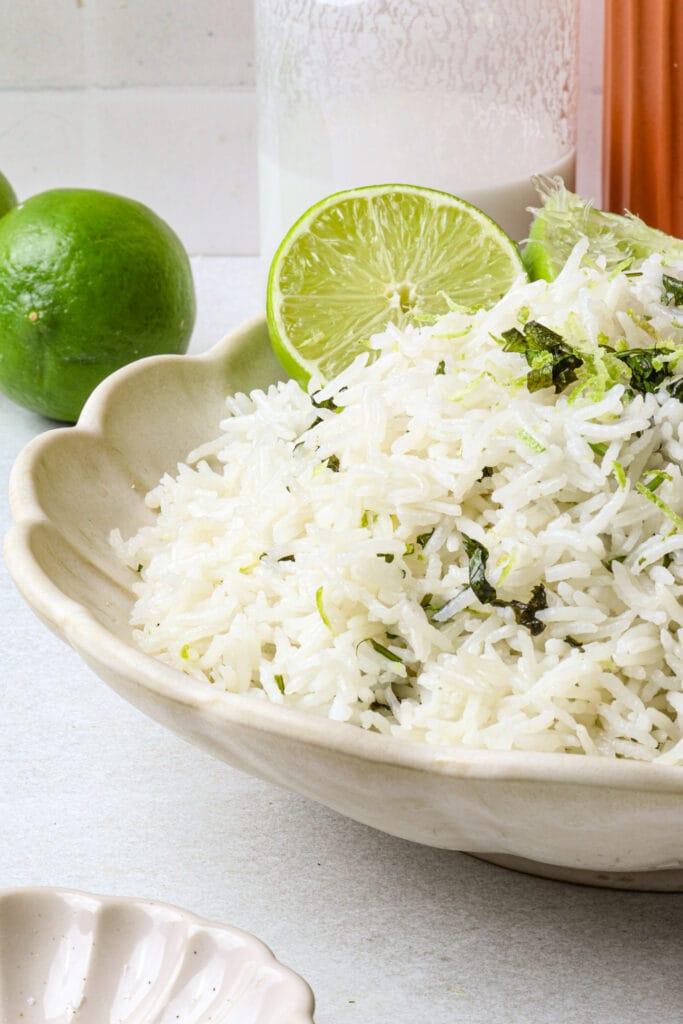
Table of Contents
How many of you cook your rice without even thinking about it? Say you’re making a curry or you need a side dish that isn’t potatoes, is the rice cooker out of the closet and on the counter faster than you can say “jasmine”? Do you boil the rice in water and rely solely on salt for flavor? If so, then you really need to check out this recipe.
Unless you’ve breezed by the title of this recipe, you’ll know what makes this rice so good. It’s got lime, it’s got cilantro, and it’s got… coconut milk! That’s right, we don’t use water for this one. Instead the rice takes a hot bath in coconut milk. The result is a subtle creaminess that makes me wanna eat rice and ONLY rice. Any curry sauce would just get in the way of what I consider pina colada–flavored jasmine.
Want to breathe new life into your same old rice dish? Say no to water and yes to coconut, cilantro, and lime.
Is Coconut Cilantro Lime Rice Healthy?
Jasmine rice (the type of rice used for this recipe) is high in carbs, so those on a keto diet may want to steer clear of this one. That said, this dish is a healthy option overall, especially when compared to other side dishes, like french fries. And while it may not appeal to keto enthusiasts, it fits with vegan, vegetarian, gluten-free, and dairy-free diets. Keto and paleo dieters will want to substitute the rice with cauliflower rice if they’re dead set on making this recipe.
Can I use Different Types Of Rice?
You sure can. I should point out, though, that we use jasmine rice for its fragrance and its stickiness once cooked. It’s also a long grain, so it stands up to the cooking process (with short grains, you run the risk of your dish turning to mush). However, if you want to use a brown jasmine rice, which retains the bran and germ layers and makes for a healthier dish, then please do. Beyond jasmine, you have as options basmati rice (a slightly nuttier flavor to jasmine), wild rice (earthier, chewier, high in protein), and quinoa, which isn’t a rice but is rich in protein and called upon regularly as a rice substitute.
INGREDIENTS
- 2 cups jasmine rice, rinsed and drained
- 1 cup coconut milk
- 2 cups water
- ½ tsp salt
- 1 tsp lime zest
- 2 tbsp lime juice
- ½ cup cilantro, chopped
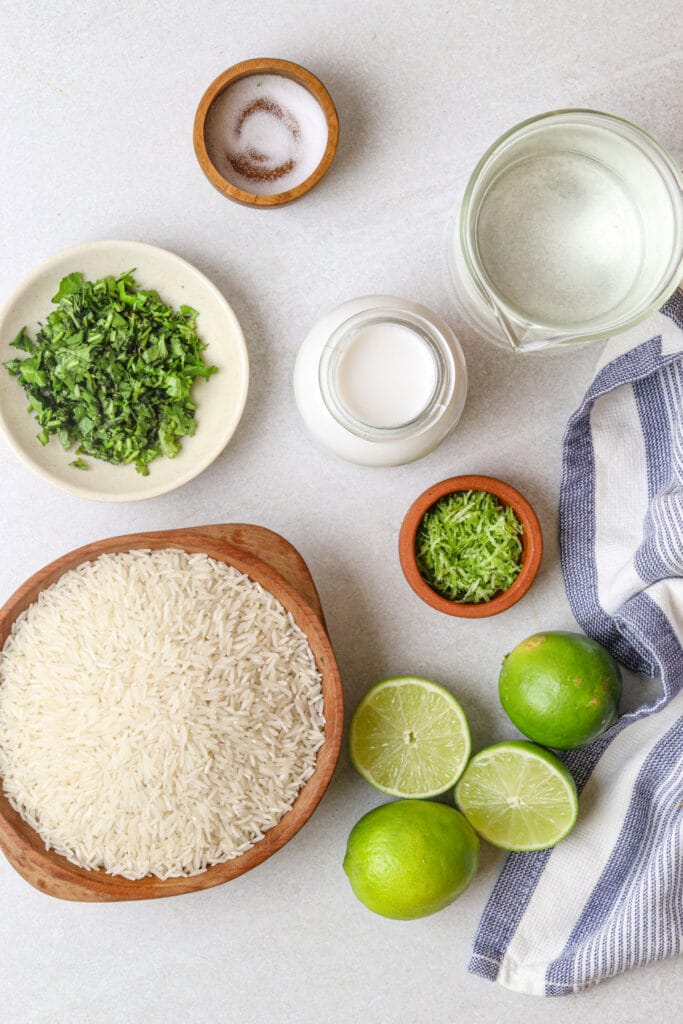
INSTRUCTIONS
Combine
Pour the rice into a large pot, along with the coconut milk, water, and salt. Stir together then cover with a lid.
Boil
Bring to the boil then reduce the heat to LOW and let simmer for 15 minutes, until the liquid has evaporated.
Steam
Remove from the heat and let it sit covered for 5 minutes.
Add
Add the cilantro, lime zest, and lime juice into the pot. Mix well.
DEVOUR!
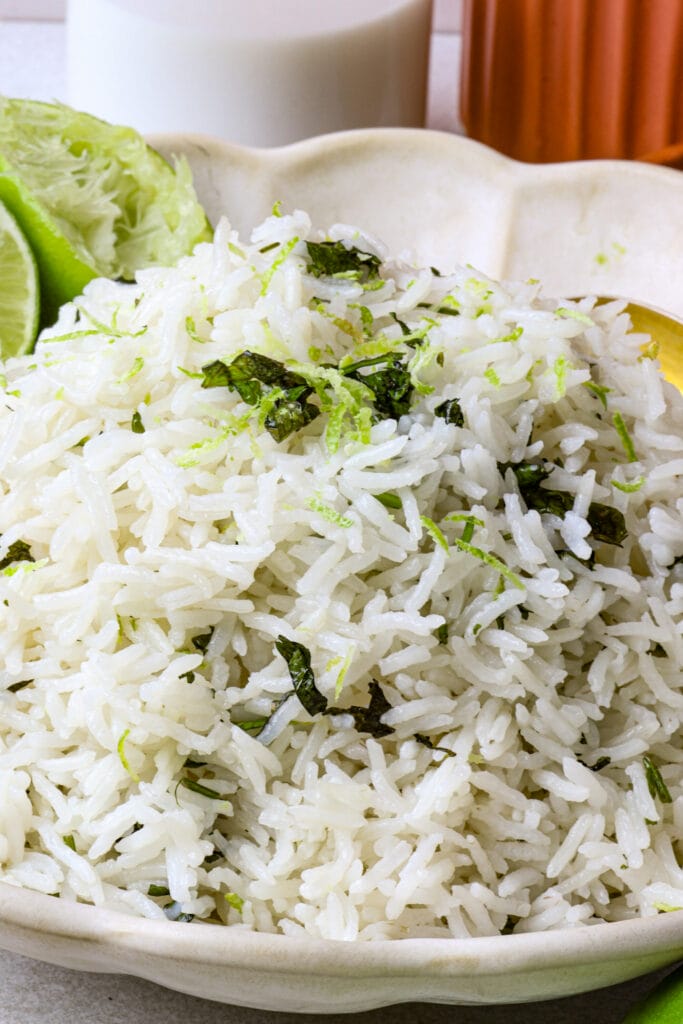
FAQs & Tips
Let the rice cool completely then store in an airtight container or resealable bag (be sure to remove as much air as possible). It should keep in the fridge for up to 4 days. You can also freeze the rice for up to 3 months. Just follow the same steps, provided the resealable bag is freezer-safe. I tend to flatten my bags of rice for easier storage. Before reheating, let it thaw in the fridge overnight. Then it’s up to you whether you warm it up on the stove or in the microwave.
Rinsing rice (especially white rice) rids it of excess starches and results in rice that is fluffy and not overly sticky and clumpy. Just put the dry rice in a sieve and rinse under cold water. Keep rinsing until the water runs clear, indicating all the starch has been washed away. Some cooks then soak the rice for 25–30 minutes to promote an evenly cooked rice. I’ve tried this method and can’t really say I’ve noticed a difference.
Yes, you can, but you should be aware of a few things first. Cream of coconut is more concentrated, so you may need to dilute it with water or unsweetened coconut milk. As well, it is high in fat and sugar, so be prepared for a rice that is both rich and sweet. Balance is the key here. You don’t want to overpower the lime and cilantro (or maybe you do. If you do, then carry on.).
Butter improves mouthfeel and adds a creamy texture to rice, which is why many choose to add it. But that’s usually reserved for plain rice. In the case of this recipe, the coconut milk brings the desired mouthfeel and texture; adding butter may overdo it.
You sure can. Just follow the recipe as it’s laid out except substitute the pot with your rice cooker.
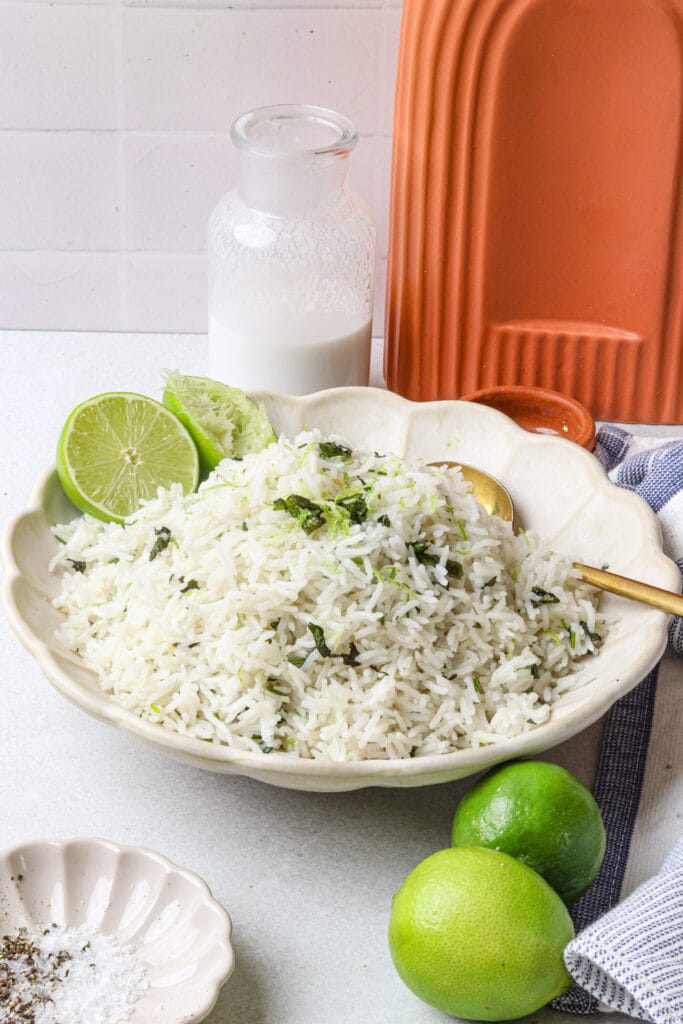
Serving Suggestions
As much as I like the idea of eating nothing but this rice dish for dinner, you should probably prepare some other things. One of those things could be Mango Curry Steak, which complements your lime with mango. Or if you’re a pescatarian, this Cilantro Lime Shrimp dish will fit in nicely, featuring as it does two of the ingredients used in your rice. You can also take elements from this Thai Pineapple Paleo Chicken Curry with Coconut Milk, again pairing the rice with dishes with a similar flavor.
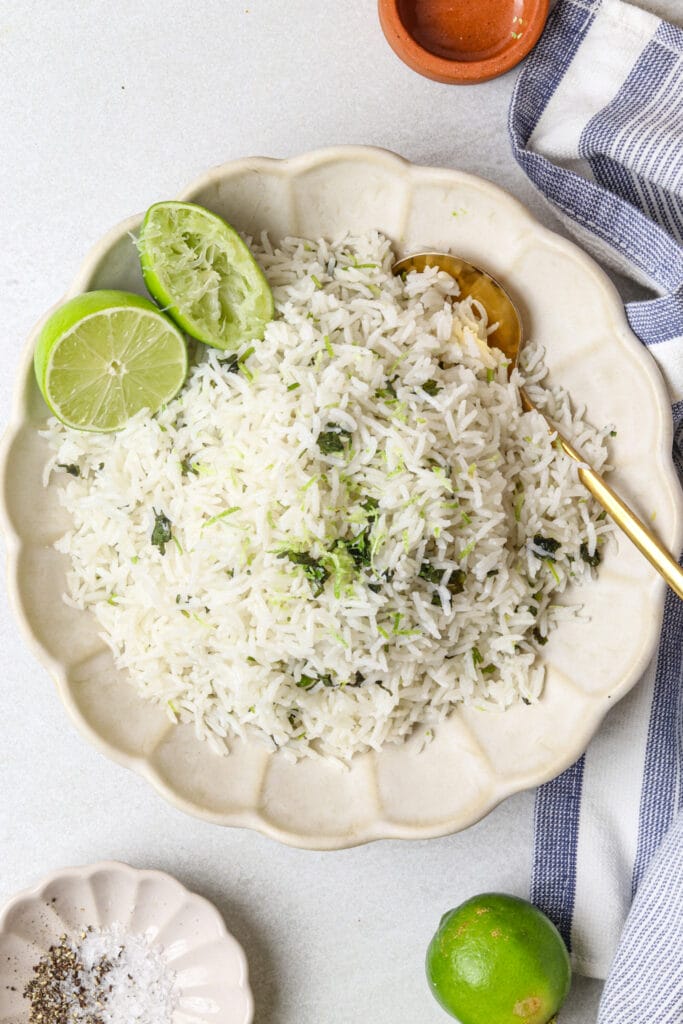

Coconut Cilantro Lime Rice
Ingredients
- 2 cups jasmine rice rinsed and drained
- 1 cup coconut milk
- 2 cups water
- ½ tsp salt
- 1 tsp lime zest
- 2 tbsp lime juice
- ½ cup cilantro chopped
Instructions
- Pour the rice into a large pot, along with the coconut milk, water, and salt. Stir together then cover with a lid. Bring to the boil then reduce the heat to LOW and let simmer for 15 minutes, until the liquid has evaporated. Remove from the heat and let it sit covered for 5 minutes.
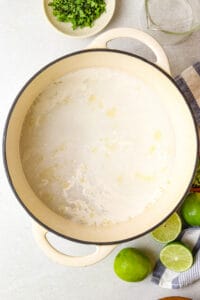
- Add the cilantro, lime zest, and lime juice into the pot.

- Mix well.
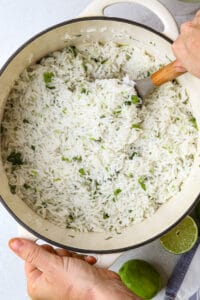
Nutrition
The post Coconut Cilantro Lime Rice appeared first on Food Faith Fitness.
References:
By: FoodfaithfitnessTitle: Coconut Cilantro Lime Rice
Sourced From: www.foodfaithfitness.com/coconut-cilantro-lime-rice/
Published Date: Wed, 28 Feb 2024 17:25:37 +0000
Frequently Asked Questions
What herbs should you take daily?
Depending on your health and wellness needs, many herbs can be taken daily to help improve your overall health.
Popular herbs for daily consumption include ashwagandha, turmeric, ginger, holy basil, chamomile, lavender, peppermint, and cayenne pepper. Ashwagandha is an adaptogenic herb that can help the body resist stress and anxiety. Turmeric is known for its anti-inflammatory properties, while ginger has been shown to aid digestion and boost immunity. Holy basil may help with managing blood sugar levels, as well as providing a calming effect. Chamomile can promote relaxation, while lavender is used in aromatherapy for its calming properties. Peppermint can help aid digestion and reduce nausea, while cayenne pepper has antibacterial properties that may boost your immunity.
As always, you must consult your doctor before taking herbs daily to ensure they are safe for you and do not interact with any other medications or herbs you may be taking.
There is no shortage of information on what foods we should eat and how much exercise we should do. But when it comes to what supplements we should take, there is a dearth of knowledge.
This is because most of us aren’t sure which ones work or which are junk. So we go online and look up whatever we can find.
But often, these articles are written by companies trying to promote their products. Which means they're usually biased toward their product.
So instead of finding unbiased advice, we end up reading marketing hype.
This makes sense since marketers make more money selling stuff than doctors.
The medical industry isn’t even allowed to advertise directly to consumers anymore. The best way to learn about natural remedies is to read independent reviews.
This is where you'll find real users sharing their experiences with each supplement. These sites give you an honest opinion of whether or not a particular herb helps.
Users will often share their experience with a supplement after taking it. This gives you a good idea of its effectiveness and any side effects.
You can also check out forums dedicated to herbalism. Here you can ask questions and receive answers based on personal experience.
Of course, there are plenty of other ways to learn about herbs.
There are books, websites, blogs, videos, podcasts, and classes. All of them provide valuable information about natural remedies.
What spice is good for inflammation?
Turmeric is one spice that can be beneficial for reducing inflammation. It contains the active ingredient curcumin, which has been studied extensively and shown to have anti-inflammatory effects on the body. Other spices like ginger, cinnamon, cayenne pepper, garlic, and cardamom may also reduce inflammation in the body. Adding these spices to your diet can help reduce inflammation and promote overall health.
Another spice that can be used to reduce inflammation is black pepper. The active ingredient in black pepper, piperine, has been studied and found to have anti-inflammatory properties. It may also help reduce pain associated with inflammation. Additionally, the spice contains antioxidants which are beneficial for overall health.
Adding black pepper to your diet may help reduce inflammation and promote overall health. Be sure to talk with your doctor before adding any spice to your diet, as some spices may interact with your medications or supplements. Eating various healthy foods, including spices with anti-inflammatory benefits, can help keep your body balanced and reduce the risk of chronic inflammation-related illnesses.
In summary, adding spices to your diet can be beneficial for reducing inflammation and promoting overall health. Spices like turmeric, ginger, cinnamon, cayenne pepper, garlic, cardamom, and black pepper have all been studied for their potential anti-inflammatory effects.
Which plant has antibiotic and wound-healing properties?
People often ask about plants that have medicinal uses. Some of these include aloe vera, eucalyptus, chamomile, and lavender. If you're wondering why there aren't any plants used for cleaning and disinfecting purposes, it's because most plants have toxic qualities.
The reason why we use herbs for medicine is that they contain compounds that stimulate our immune system. This means that they help us fight infections and heal wounds.
Some plants also have anti-inflammatory properties. These include ginger, turmeric, and mint.
Herbs such as basil, fennel, marigold, and oregano are great for cleansing the body.
There are even some plants that help prevent cancer. Research shows that black raspberries may reduce the chances of developing breast cancer. The same goes for broccoli. It can help prevent colon cancer.
How is basil used for medicinal purposes?
In ancient times, doctors would prescribe basil leaves to treat colds and coughs. Today, basil contains powerful anti-inflammatory properties, making it an ideal remedy for arthritis, asthma, bronchitis, eczema, gout, hay fever, indigestion, migraines, menstrual cramps, sinus infections, sore throats, ulcers, varicose veins, and more.
Basil is also known for its ability to help protect against cancer, heart disease, diabetes, skin conditions, and even aging.
Basil is often referred to as "the herb of grace" because it helps us relax and unwind after stressful situations. It is also said to improve memory and concentration, boost energy levels, increase libido, and enhance athletic performance.
The list goes on and on. Basil is a versatile plant that offers a wide range of benefits for our health and well-being.
How do you make medicinal herbs?
There are many different methods to make herbs into medicinal products. The most common method is to dry the herbs in a warm, dark location before grinding them into a powder or extracting their essential oils. This can be accomplished by hanging herbs upside down in bunches, laying herbs on a drying screen, or using a food dehydrator.
Once dried and ground, herbs can be stored in airtight containers for future use. Other herbs may require special preparation, such as infusing herbs into oil or vinegar, making tinctures with alcohol, or distilling herbs to create essential oils.
Learning the correct techniques for preparing herbs can help ensure that they retain their medicinal properties and potency for optimal health benefits. Using fresh herbs is usually best, but herbs can also be grown in a pot or garden and harvested when they are mature. Herbs can be purchased at health food stores, online retailers, and specialty shops.
No matter where herbs come from, the preparation techniques remain the same; drying herbs in a warm location followed by grinding or extracting the essential oils. You can make your medicinal herbs with the right herbs and preparation techniques.
When making herbal preparations, it is essential to remember that herbs can vary in potency, so always dilute herbs before use or follow the directions on any product label. Additionally, herbs are best used fresh, as many of their beneficial components degrade over time.
Following safety guidelines and paying attention to the potency of herbs can help ensure that you get the most benefit from your herbs. With a bit of practice and preparation, anyone can make therapeutic herbs with medicinal properties. Remember that herbs should never replace any medical advice or treatments prescribed by a doctor. Always consult a licensed healthcare professional before using herbs medicinally.
What is the difference between "regular" and smoked paprika powder?
Regular Paprika Powder (Piment d'Espelette) is an essential ingredient for our recipes. We use it for its intense flavor and color. It's also used as a spice and seasoning agent. Smoked Paprika Powder (Paprika Chorizo) adds a smoky taste and aroma to dishes. Both types of Paprika Powder come from Spain, where they grow the best peppers in the world.
Smoked Paprika Powder (Chorizo Paprika) is made from red peppers, which are dried slowly in special ovens. This gives them a rich flavor. They are then ground and mixed with salt, garlic, and spices.
Regular Paprika Powder (Espelette Paprika) is made by grinding green bell peppers without additives.
Which herbs are healing herbs?
If you look for healing herbs, you won’t find them in the supermarket. There isn’t any place to buy them. There is no store selling them.
You haven’t been able to find healing herbs because they aren’t sold anywhere. They are grown right here in our backyard.
Healing herbs are plants that grow naturally in North America. Like many common household items, these herbs grow throughout the United States and Canada.
These herbs treat minor ailments such as colds, flu, sore throats, coughs, and headaches. Many of these herbs have been used for centuries to help heal wounds and promote overall health.
Of course, when we say “heal,” we mean more than simply treating an illness. We also refer to the ability of these herbs to restore balance and harmony within ourselves and the world around us.
For example, the chamomile herb helps relieve stress. This means that if you feel stressed out, you may benefit from taking chamomile tea. Chamomile tea has been shown to reduce anxiety and nervous tension.
In addition, chamomile tea has been proven effective in relieving insomnia.
Chamomile tea has many other benefits, including its ability to ease stomach aches and gas pains and even improve digestion.
Another popular healing herb is Echinacea. Echinacea is known for helping to fight infections and boosting the immune system.
Echinacea is commonly taken internally and externally to fight infection, prevent viral diseases, and boost immunity. It is safe to use during pregnancy and lactation.
Echinacea also helps reduce muscle pain and inflammation. You can take echinacea orally or topically (as an ointment).
This herb is available in both liquid and capsule form. Liquid echinacea is often mixed with honey and lemon juice. The mixture is then strained and consumed.
Capsules are usually made of freeze-dried plant material. They contain standardized amounts of active ingredients. To use capsules, swallow one or two a day.
The third type of herbal remedy is called tincture. Tinctures are alcoholic extracts of herbs. They are typically used to treat internal problems. Tinctures are generally diluted before being ingested.
Tinctures can be taken orally or applied topically. For oral consumption, dilute tinctures with water. Some people prefer to mix tinctures with food.
Tinctures are easy to prepare. Put about one tablespoon of dried herb into a bottle containing enough alcohol to cover the herb completely. Allow the mixture to sit for several weeks. Then strain and consume.
You may want to try some of these natural remedies to see which ones work best.
Statistics
- The herbs market is highly competitive, with over 1,000 herb suppliers and over 15,000 herbs products available in the United States alone.
- For those with high cholesterol, garlic supplementation appears to reduce total and/or LDL cholesterol by about 10-15% (72Trusted Source73Trusted (healthline.com)
External Links
[TAG45]
- Antioxidant capacity of 26 spice extracts and characterization of their phenolic constituents - PubMed
- Cinnamon: A Multifaceted Medicinal Plant - PMC
[TAG48]
- Peppermint oil (Mintoil®) in the treatment of irritable bowel syndrome: A prospective, double-blind placebo-controlled randomized trial
- Curcumin reverses the effects of chronic stress on behavior, the HPA axis, BDNF expression, and phosphorylation of CREB
[TAG51]
- Ashwagandha | Memorial Sloan Kettering Cancer Center
- Grape Seed | Memorial Sloan Kettering Cancer Center
[TAG54]
How To
What to look for in herbs?
Herbs contain natural compounds that may help treat various conditions. In addition, herbal remedies may provide relief when used along with conventional treatments.
Herbal remedies include teas, capsules, tablets, ointments, creams, lotions, oils, and topical applications. Some of these products are meant to be taken internally, while others are applied externally.
The most common uses of herbal remedies include relieving minor aches and pains, treating cold symptoms, reducing fever, controlling coughs and sore throats, easing digestion problems, soothing skin irritations, alleviating menstrual cramps, and providing general health benefits.
When buying herbs, look for the following:
- Freshly picked plants. Avoid dried herbs unless they've been stored in a cool place. If possible, buy herbs directly from farmers' markets.
- Pure extracts. These are made by extracting the active ingredients from herbs using alcohol or water. Look for 100% pure extractions.
- Certified organic herbs. Organic herbs must meet strict standards set forth by the USDA.
- Natural flavors. Many herbs have strong scents that can overwhelm other foods. Adding flavorings such as vanilla, almond, or orange helps mask their smell.
- Potency. The amount of active ingredient per unit weight varies depending on the type of herb.
- Packaging. When purchasing herbs, check the packaging to ensure that it's clean and free of chemicals.
 |
[TAG56]Hello hello! Just wanted to pop in with a cute little life update. ♡ I’m delighted to share that our sweet son, Milo Alexander Martin, came to join our family |
 |
[TAG57]This vibrant lemony broccoli pesto pasta is quick and easy to make and full of fresh flavors. Your veggies, greens, and pasta…all in one gorgeous dish! ♡ We’re |
 |
[TAG58]This simple roasted carrot soup recipe is made with creamy tahini and topped with crispy za’atar chickpeas. Naturally gluten-free, vegetarian and vegan. If you |
 |
[TAG59]My longtime favorite flourless cake recipe is decadently rich and delicious, naturally gluten-free, and easy to make in under 1 hour! Trust me, this flourless |
 |
[TAG60]Easy to make full flavoured recipes. Life is too short for boring food! |
 |
[TAG61]This vegetarian cabbage roll soup is filled with protein-rich lentils and all of the delicious flavors you love from traditional cabbage rolls. Naturally |
 |
[TAG62]These zesty roasted sweet potato and chickpea bowls are layered with sautéed spinach and brown rice and tossed with my favorite 4-ingredient chipotle tahini |
 |
[TAG63]This classic matcha latte recipe is easy to make and customize to your liking and always so delicious. The older I get, the more I’m convinced that one of |
 |
[TAG64]This veggie-loaded broccoli cheese soup recipe is perfectly velvety and creamy without using heavy cream. Instant Pot, Crock-Pot and stovetop options all |
 |
[TAG65]HEALTHY & KID-FRIENDLY MEALS easy dinner recipes made in minutes. The Latest Recipes st. Patrick's Day Recipes Hello! I'm Sara! Welcome to Dinner at the Zoo! |
 |
[TAG66]This winter farro salad recipe is made with the most delicious blend of seasonal fruit, greens, nuts, crumbled cheese and tossed with a vibrant orange ginger |
 |
[TAG67]This lovely white wine sautéed mushrooms recipe is quick and easy to make, full of rich savory flavors, and can pair well as a side dish with many different |
 |
[TAG68]This traditional Swedish meatballs recipe is bursting with rich, savory flavors and topped with a creamy gravy. Always so comforting served over mashed |
 |
[TAG69]This classic Irish coffee recipe is easy to make with 4 ingredients in just a few minutes. Always so warm and cozy! Let’s warm up with a hot mug of Irish |
 |
[TAG70]From comfort foods to indulgent dishes browse hundreds of recipes that your family will love and make over and over again. Cooking Classy has never been easier, |
 |
[TAG71]This snickerdoodle blondies recipe is irresistibly rich, buttery, tangy, and sprinkled with a crunchy cinnamon-sugar topping. Yes, they’re just as good as you |
 |
[TAG72]This creamy garlic mushroom orzo pasta recipe is easy to make and always so comforting and delicious. Say hello to one of my favorite back-pocket recipes |
 |
[TAG73]This 3-ingredient homemade dog treats recipe is quick and easy to make and cut into whatever shapes you love. This holiday cookie season, we can’t forget about |
 |
[TAG74]"Food Wars" hosts Harry Kersh and Joe Avella travel across NYC to find the best Bodega sandwich in the city. They'll be visiting four different locations in |
 |
[TAG75]A family food blog with hundreds of simple, tested and approved recipes. Find easy step-by-step photo cooking instructions and video recipes. |
 |
[TAG76]🇮🇩 Street Food in Bali: 👕 T-shirts: 🌶 Ghost Chili: SURABAYA, INDONESIA: Welcome to Surabaya, the second biggest city in Indonesia, and an |
 |
[TAG77]This cake is based on the chocolate sheet cake recipe Ree made for years and years, originally given to her by her mother-in-law, Nan Drummond. Nan gave Ree |
 |
[TAG78]Hello friends..! In this video we both brothers are going to Try Spiciest Food From Zomato. In our upcoming vlogs we are gonna do lots of different food |
 |
[TAG79]#shorts #food #fastfood #mcdonalds #tacobell |
 |
[TAG80]find out hundres of delicous food recipes |
 |
[TAG81]There are just too many delicious foods in Cloudy With A Chance Of Meatballs to only do 1 video so we are back with Try Not To Eat Cloudy With A Chance Of |
 |
[TAG82]Today, I Zhong, am going to eat 100 years of foods. First we start in the 1900’s with Hershey kisses. Then we try a peanut butter and jelly sandwich. Next we |
 |
[TAG83]Can you cook steak with a flamethrower? Cook eggs in the microwave? We've tested 100 of the most viral food hacks to give you answers. SUBSCRIBE TO CATCH |
 |
[TAG84]Weird History Food is getting into some Misconceptions Around Popular Foods. We all know how to eat, and most of us know how to cook, at least on some basic |
 |
[TAG85]The food blog with mostly healthy recipes made with real, whole foods inspiring more people to get into the kitchen and cook something good. |
 |
[TAG86]Jeff Mauro's Coconut Shrimp Salad is perfect for a light weeknight dinner, but it tastes just like vacation 🍤🌴 #FoodNetwork #JeffMauro #CoconutShrimp |
 |
[TAG87]This kimchi beef noodle soup recipe is made with your choice of noodles, veggies, and a richly seasoned sesame kimchi broth. Stovetop, Instant Pot and |
 |
[TAG88]Hot buttered rum is the perfect cozy cocktail to warm you up on a winter’s night and perfect for easy entertaining. Another warm cocktail recipe that needs to |
 |
[TAG89]This gingerbread cake recipe is easy to make, perfectly moist and fluffy, and made with a delicious blend of molasses and warming spices. This is one of those |
 |
[TAG90]A food blog with hundreds of quick and easy dinner recipes. Classics done right, incredible one pot recipes, Asian takeout at home and holiday feasting! |
.png)





